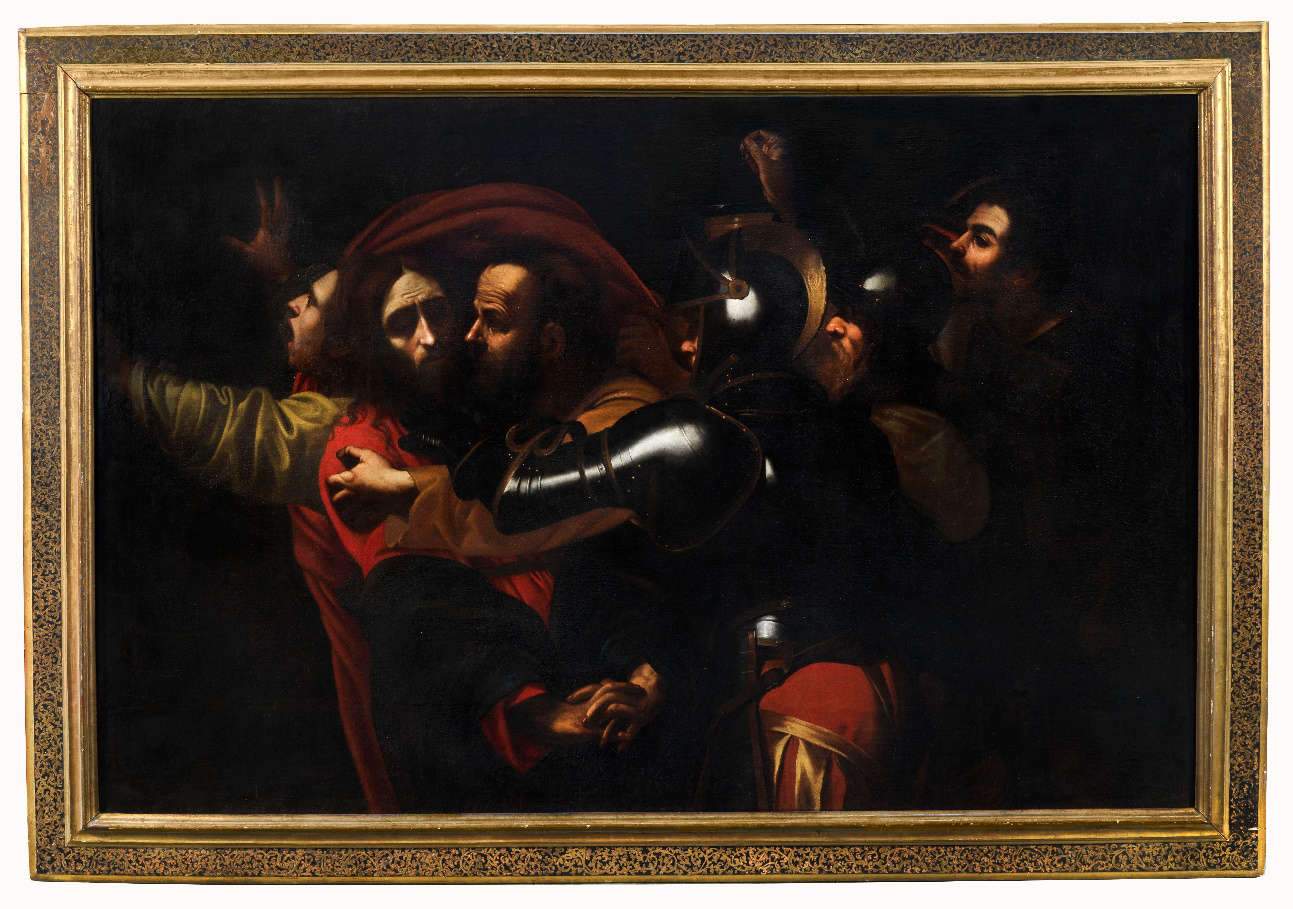A work attributed to Caravaggio returns to public display seventy years after the last time. It happens from October 14, 2023 to January 7, 2024 in Ariccia, at Palazzo Chigi: the exhibition, entitled Caravaggio. The Taking of Christ from the Ruffo Collection, curated by Francesco Petrucci, comes at the conclusion of the restoration and diagnostic investigation of the Taking of Christ, considered by the curator to be the earliest version of Caravaggio’s well-known Taking of Christ now in the National Gallery of Ireland in Dublin.
The work had only been exhibited in 1951 at the historic Caravaggio and Caravaggesque Exhibition held at the Palazzo Reale in Milan under Roberto Longhi, when it was dirty and with various repaintings, which were removed after the recent restoration. The investigations revealed radical changes and extensive repainting, which according to Petrucci corroborate the autographism, which had also been advanced by other scholars some time ago, for example by Denis Mahon when the work reappeared on the market in 2003, the year in which it was purchased by antiquarian Mario Bigetti. The following year, because of its exceptional nature, the painting was notified by the Italian State by Decree of December 2, 2004, of the Minister of Cultural Heritage as a work of special national interest.
The Ariccia exhibition documents for the first time the provenance of the work: the Mattei collection, the Colonna di Stigliano collection and the Ruffo di Calabria collection, through whose medium it came to the current owner. The Taking of Christ from the Mattei collection, known through numerous copies and presumed originals, is one of the most spiritually intense and pathos-filled compositions of the Rome of Michelangelo Merisi da Caravaggio and constitutes a sort of private-purpose counterpart to the astonishing canvases of the Contarelli Chapel in San Luigi dei Francesi (1599-1600) and the Cerasi Chapel in Santa Maria del Popolo (1600), which mark a radical turning point in terms of expression in the Lombard artist’s production, after the prevalence of genre and mythological-themed subjects of earlier years. The Palazzo Chigi exhibition also traces the controversial history of Caravaggesque’s powerful invention and its pictorial evidence, which has a pinnacle in the two redactions from the Ruffo di Calabria collection, found by Roberto Longhi in 1943, and from the Jesuit Company in Dublin, on deposit at the National Gallery of Ireland since 1993.
The two versions, according to Petrucci, are both autograph, but endowed with formal and expressive autonomy, with a precedence in his opinion of the Ruffo version, of which the Irish one would be a replica with variants revisited in pictorial and plant characteristics, improving its classical decorum in an iconographic and aesthetic sense compared to the “expressionist” and highly dramatic character of the prototype. The complexity of implantation, iconographic, iconological and conceptual contents of the Caravaggesque composition, which has no counterpart in Merisi’s works for private use, comparable in underlying issues to those of altarpieces, deserves a monographic treatment, the subject of this event.
Caravaggio’satelier is then ideally reconstructed on thealtana of Palazzo Chigi, placing the canvas on a black background wall, with light coming diagonally from the top left, as historical sources (Bellori, Mancini) testify. Thealtana in fact in the past had also been used as a workshop for the restoration of paintings, as was often the case on the altanas of Roman palaces. In the same room are retro-reflective light panels with an x-ray of the work, its reflectography and a reproduction of the Dublin version. Again, didactic panels document the 15 copies of the composition and its history, and Cavalier d’Arpino’s The Taking of Christ, a coveted Renaissance painting by Giorgione depicting the same subject, and a version of Francesco Villamena’s Baruffa di Bruttobuono, references for Caravaggio’s composition, are also displayed. On the other hand, in the square room, located under the reredos, contemporary copies from Caravaggio’s famous paintings executed by painters Nicola Ancona, Giancarlo Pignataro, and Guido Venanzoni are on display.
The exhibition, also supported by the intervention of the cultural association “Comitato di San Floriano” of Illegio, is sponsored by the Fondazione Meeting del Mare - C.R.E.A. (culture religions and art). The catalog is financed with a contribution from the BCC Foundation of the Roman Castles and Tusculum. The installation is curated by Glocal Project Consulting. The exhibition will be hosted later in Naples.
Visiting hours: daily, except Mondays, from 10 a.m. to 1 p.m. and 3 p.m. to 6 p.m. Ticket 5 euros. Information at https://www.palazzochigiariccia.it
 |
| The Taking of Christ on display in Ariccia: first version of Caravaggio's well-known painting? |
Warning: the translation into English of the original Italian article was created using automatic tools. We undertake to review all articles, but we do not guarantee the total absence of inaccuracies in the translation due to the program. You can find the original by clicking on the ITA button. If you find any mistake,please contact us.